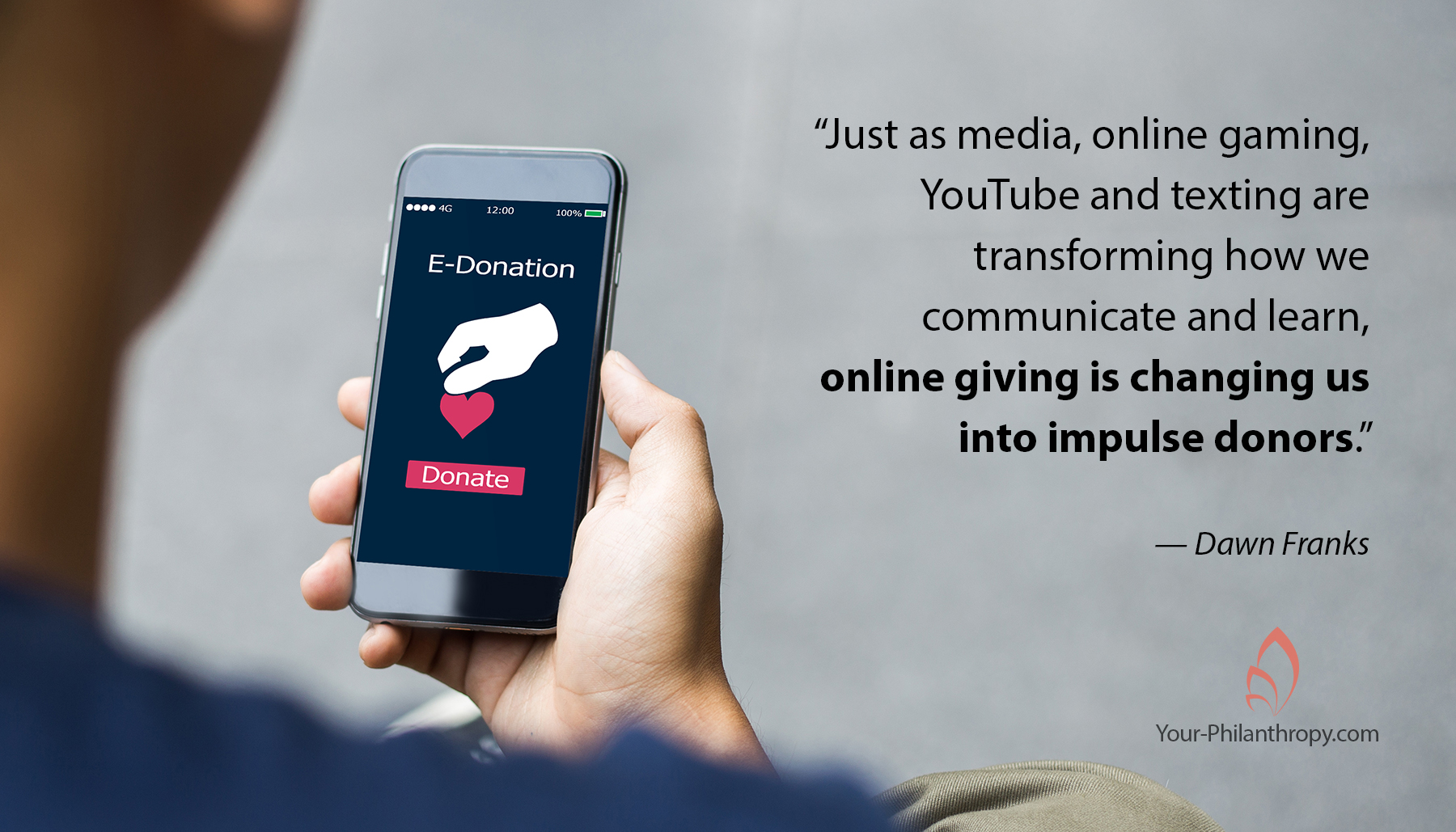Have you made a gift online this year? Chances are the answer is yes. A growing number of donors respond to a Facebook post or a Tweet to give but ask few questions about the group or nonprofit making the ask.
A few clicks and it’s done. Gift made. Endorphins surge. It feels good.
Just as media, online gaming, YouTube and texting are transforming how we communicate and learn, online giving is changing us into impulse donors.
From the nonprofit perspective, it’s a terrific trend. Tap our emotions as we react to images and reports on television and the internet and wait for the donations to flow. The statistics say if we give online once, we’ll give to them again.
In a Blackbaud Institute study of giving, the online-only retention rate for repeat donors was 63%. We repeatedly give online but are not as likely to repeat giving by personal check.
The last ten years have seen a sizable increase in online giving. Online giving and micro-giving, or small gifts made often, are almost interchangeable. The nineties saw the rise of smart philanthropy or impact giving. As the century turned, articles and books abounded on the how-to and step-by-step methods for ensuring the best and most impactful donations.
That was then. The growth of online and micro giving has seen a nearly 10% growth rate in the last three years. Almost 9% of all funds raised in 2019 were from online giving, according to Blackbaud, and 26% of us made our donations on mobile devices.
The Blackbaud Institute tracks some $36 billion in U.S.-based charitable giving, creating an index of giving trends that draws a clear picture that impulse giving is growing.
We’re more easily drawn to a cause online, giving both our dollars and absolute trust. We ask few, if any, questions. Alarm bells should be ringing about now.
America is now COVID-19 weary, and our mailboxes full of no-go gala invites. Online giving opportunities run neck and neck with no-go galas. In a special report from the Better Business Bureau, COVID-19 and the Charitable Sector, 56.7% of nonprofit respondents indicated they might find new or expanded ways to raise funds online.
Bombarded by images on television and the internet of racial tension, bad acts, riots, and peaceful protests, donors make quick donations online to organizations they think are at the forefront of change. Names and brands can be confused at first glance. It takes digging around to find out what and who you are really benefiting from your gift.
For example, recent media articles question the lack of transparency of some large national organizations increasingly visible in the Black Lives Matter movement.
Did you know you are giving through a fiscal agent to make a gift to the Black Lives Matter Global Network Foundation? The BLMGN is not currently a qualified nonprofit organization, so they partner with a qualifying nonprofit, ActBlue Charities, to receive donations designated for their work. BLMGNF is focused on eradicating white supremacy, building local power to intervene in violence inflicted on Black communities and promotes #Defund the Police.
Meanwhile, a different California-based nonprofit called the Black Lives Matter Foundation raises money to “bring the community and police closer together.” They support survivors and families that have lost a relative or loved one due to an unjust or questionable police shooting.
Shift to another group that has drawn a lot of media attention – wounded warriors. Nonprofits using the words wounded and warrior in their name abound: The Wounded Warrior’s Project, Wounded Warrior Program, Army Wounded Warrior Program, Wounded Warrior Outdoors, Texas Wounded Warrior Foundation and more. Annual donations to each organization range from hundreds to millions of dollars. They provide all kinds of services, sometimes overlapping, sometimes serving only a select group of wounded soldiers, some nationwide and others focused on specific states or communities.
Online choices are abundant whether you give to save something, feed, shelter, or educate someone.
My message for all donors is to pay attention. The impulse to give now and give fast feels good. No one likes a burst bubble – discovering the organization is not doing work that matters to you, or your donation not used as you hoped.
Online, impulse giving is not going away, so donors must pay attention to who and where they give. I’m curious; how do you give online?
Like it? Use it. Share it. Comment below.


0 Comments